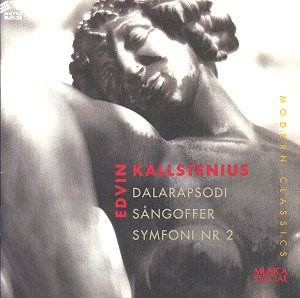Edvin KALLSTENIUS
(1881-1967)
Dalarapsodi (1931)
Sångoffer for baritone and orchestra (1944)
Symphony no. 2 (1935)
 Olle Persson (bar)
Olle Persson (bar)
Swedish Radio SO/B Tommy Andersson
rec Berwaldhallen, Stockholm, June 1998
 PHONO SUECIA PSCD 701
[68.23]
PHONO SUECIA PSCD 701
[68.23]
Crotchet
AmazonUK
AmazonUS

For eighteen years Kallstenius worked as music librarian with Swedish Radio
receiving few performances and little attention. His one 'hit' was the
Ballad (Visa) section of Dalarapsodi. For the rest
(including five symphonies, Swedish Requiem, Greek wedding cantata)
time had passed him by and Wirén, Larsson, Blomdahl, Hambraeus now
held the attention of Swedish audiences.
He studied in Leipzig but always claimed that it was hearing Nikisch conducting
Strauss that had galvanised him as a composer. These experiences as well
as the music of Reger and Debussy fixed his developmental itinerary. In much
the same way as some composers develop an idée fixe so Kallstenius,
deeply impressed by the storyline of Schreker's Der ferne klang,
self-identified with the 'distant sound' within his own creative imagination.
He made its pursuit and expression his life's pilgrimage.
The Dalarapsodi has the clean textures of Sibelius 6. It frames
a slow-motion contemplative sunset of poignant radiance (some parallels with
Vaughan Williams 5) between music of sprightly and gawky folksiness.
No wonder this work has done well in Sweden. The Rabindranath Tagore settings
of Sångoffer have something in common with Vaughan Williams'
Herbert songs but over that is dusted a Mahlerian heroism, a hint of Delius
and an uncanny sense of the same richness of foliage that you encounter in
Havergal Brian's Wine of Summer (Symphony No. 5). The recording is
quite breathtaking with a real sensitivity to variations in dynamics. The
textures are lithe; not overloaded. Each song gets progressively longer:
the first at 2.35 the fourth at 6.43.
The Second Symphony was spoken of by the composer as the best of his
compositions. It is cleanly woven but lacks rhythmic verve preoccupied instead
with texture and reflection sounding like a luminously clear and cold counterpart
to the dreamier sections in Rosenkavalier. Aside from some
alert rhythmic figures in the first movement this is music of unhurried
sun-drenched reflection with some resonances with the valedictory Mahler
(perhaps the Adagietto from the Fifth Symphony) or the sultry latter-day
pages of Valentin Silvestrov's Fifth Symphony. Music for contemplation and
concentration.
Recording and documentation are very fine indeed; performances also. Perhaps
when CPO have finished the Atterburg cycle we can hope for Kallstenius's
five symphonies.
Rob Barnett
PO Swedish Music Information Center
Box 27327
SE-102 54 STOCKHOLM
Sweden
www.mic.stim.se

